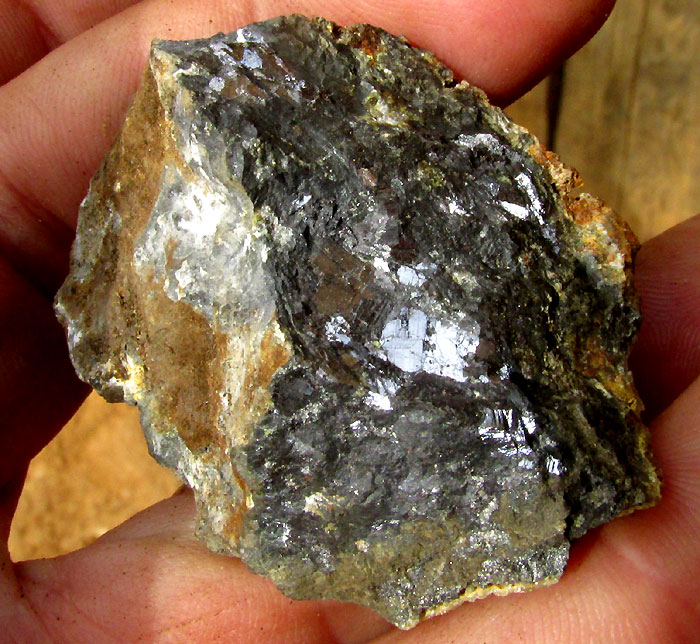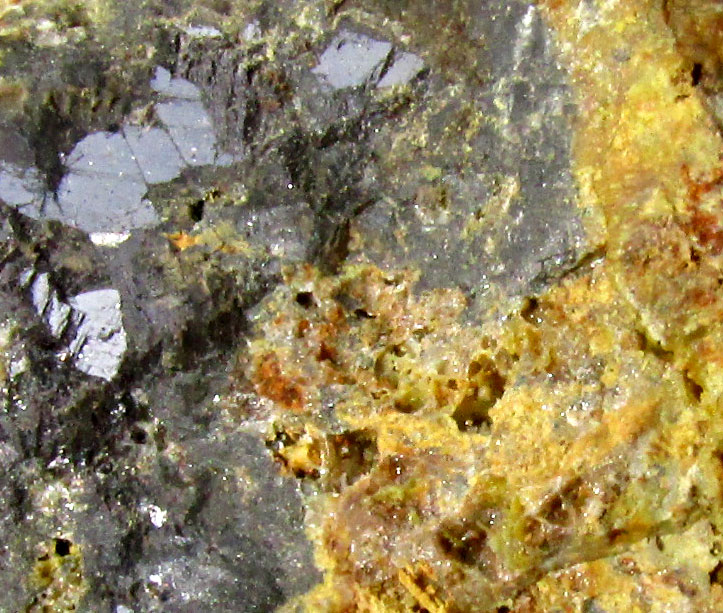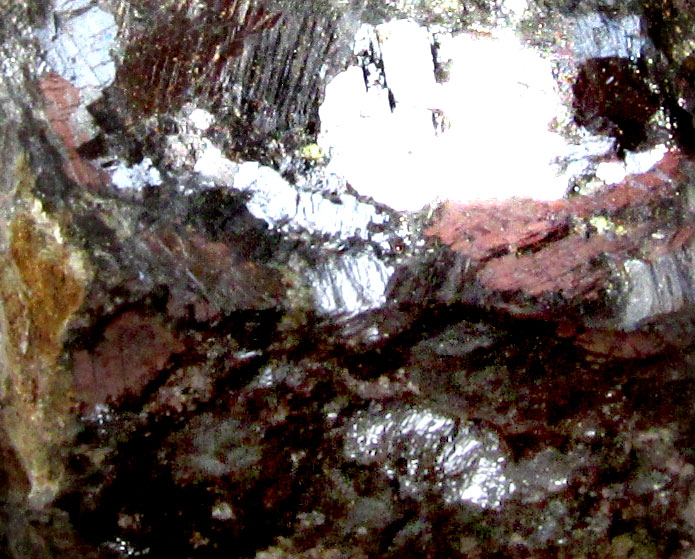Excerpts from Jim Conrad's
Naturalist Newsletter
entry from field notes dated January 19, 2023, taken along a steep, one-lane gravel road ascending a forested, northeast-facing mountain slope, elevation ±2,380m (7600 ft); bedrock of Cretaceous limestone; on the south side of Pinal de Amoles, Querétaro state, MÉXICO, (N21.134°, W99.629°)
GALENA, MAYBE CONTAINING SILVER?

Atop a ridge where clouds must frequently sweep through the forest as cold fog, we came upon an old man shoveling dirt into a deep rut of the steep, rocky, one-lane road. Explaining that we were looking for interesting plants to photograph, he perked up and told us to follow him to his little house constructed of thick wooden planks, occupying the ridge's crown. Nailed onto the wall of his home was a drying collection of herbs he declared as medicine against the COVID virus. Once we'd properly admired his drying herbs, he reached onto a nearby window sill and retrieved the above rock, which was one of several. He said it was silver, from a vein he knew where to find.
The rock's metallic luster, its many flat crystal faces and -- more than anything -- it's surprising heavy weight, all brought to mind a mineral I'd first met as a specimen in a big tray in a university mineralogy class. That mineral had been labeled galena, Lead Sulfide, PbS. I was pretty sure that the man's rock was galena, though maybe the white and dingy gray-orange splotches on the sample's surface, shown closer below, had something to do with silver:

Here's another close-up, this one showing tiny particles within the galena matrix, and for all I knew they could have been bits of silver:

I'd studied the Pinal de Amoles area's geology on the "Carta Geológico-Minera Jalpan F14-C48 Querétaro e Hidalgo" geology and mining map, where numerous mines were designated in the Pinal de Amoles area. On the geology map, the nearby San Rafael and Samita mines had been shown as producing lead and silver. The Montecristo mine produced copper and gold.
The map designated the bedrock in the area as Cretaceous-Era in age, of the El Doctor Formation, deposited maybe 110 million years ago. Elsewhere the El Doctor Formation is described as a light gray limestone formed of lime mud. The lime mud was deposited at the bottom of a marine basin under very salty, or hypersaline, and/or poorly oxygenated conditions.
This brings up the question of what metallic galena is doing in an Eastern Sierra Madre mountain range of limestone. Wikipedia's Galena page suggests the answer when it describes galena as typically found in hydrothermal veins. Hydrothermal veins are sheetlike bodies of crystallized minerals occupying rock fractures. The minerals got into the fractures by way of being dissolved in water carried into the fractures, and over geological time the minerals precipitated in what today we see as veins in rock joints.
The mountains around Pinal de Amoles are much crisscrossed with ancient faults, where on a large scale rock on one side of a fault, or rock fracture, slipped past rock on the other side. Faults are to be expected in the Eastern Sierra Mountains, which themselves were raised from the ocean floor by mighty, rock-bending tectonic forces within the Earth. There's been volcanic activity in the area, too, the volcanism carrying to the Earth's surface both water and minerals -- minerals such as lead and silver. The big igneous intrusion in the Pinal de Amoles area is known as the "Stock Pinal de Amoles."
So, does our galena rock encrusted with obvious other minerals, and with tiny specks of something in its matrix, contain silver? Galena bearing silver is referred to as "argentiferous galena," and if on the Internet you do an image search on that term you can see pictures of rocks looking like ours -- bearing white to orangish-gray encrustations. But that doesn't prove anything, since lots of minerals can form such encrustations. On the Wikipedia Galena page I read that "In some deposits the galena contains up to 0.5% silver," indicating that when silver is present in galena, there's not much of it. This suggests that the generous amounts of white to orangish "impurities" on our galena sample may be something other than silver, or maybe contribute only tiny amounts of it.
At the Mindat.Org website I read that in galena usually silver is present as tiny inclusions of various silver sulfosalts. Tiny inclusions sound like the minuscule particles seen in the galena matrix. When I search on the keywords "galena silver sulfosalts," once again I see photos of galena looking just like ours.
Returning to the bottom-most of picture our above pictures, notice the band of white minerals crossing the image's center horizontally. In places it seems to consist of many very slender needles packed next to one another. In a 1928 article by A. Lucas, entitled "Silver in Ancient Times," I read that "Native metallic silver is practically pure and occurs only in very small quantity, generally in the crystalline form, as needles, filaments, network or arborescent shapes, though also, but more rarely, massive, in nuggets and thin plates." Maybe those needles in the white vein are silver.
Finally, on a 2016-published page at the ElFinanciero.Com.MX website, there's an article written by Lourdes Durán Peñaloza entitled "Reactivan dos minas de plata y antimonio en Pinal de Amoles, Querétaro." It reports that in the Pinal de Amoles municipality area, the municipio, at that time eight permits had been granted for mining, of which four were active, benefiting about 200 families. The page announced that two mines had been reactivated, for the extraction of silver and antimony, providing 50 more people with work.
Therefore, it's entirely possible that our friend's window-sill sample of galena truly bore silver, and that the old man knew better than I how to spot silver in a galena sample.